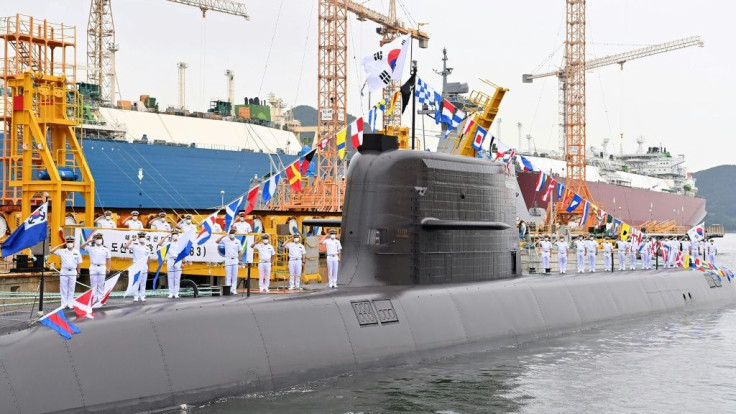South Korea: New Kid On The SLBM Block
Missile test headlines on the Korean peninsula are almost invariably about the nuclear-armed North, but this week the South fired a submarine-launched ballistic missile of its own as it rapidly scales up its military capabilities.
The successful test puts the South among the elite flotilla of nations with proven SLBM technology, and Seoul is on a multi-billion-dollar drive to develop its defence forces.
On the other side of the Demilitarized Zone that splits the peninsula, the North maintains the world's largest standing army and has made rapid progress in its nuclear weapon and ballistic missile programmes, earning it multiple international sanctions.
But Seoul's SLBMs shift the strategic balance, enabling it to respond with a surprise second strike even if its land-based forces were destroyed in a conflict.
Wednesday's launch took place from the Ahn Chang-ho, a new 3,000-ton missile submarine named after an independence campaigner.
Afterwards President Moon Jae-in -- who has long pursued engagement with Pyongyang to bring it to the negotiating table -- told the vessel's commander: "Activist Ahn Chang-ho remarked in 1921 that 'The only thing we can trust and wish for is our strength'."
South Korea maintains a conscript army to defend it against the North, which invaded in 1950, and this month unveiled a blueprint to raise its defence budget to 70 trillion won ($60 billion) by 2026, with a focus on developing "cutting-edge advanced technologies".
It is adding more Aegis-class destroyers to its navy and building more SLBM submarines, as well as replacing ageing F-4 and F-5 jets with indigenously-designed KF-21 fighters.
The state Agency for Defense Development (ADD) also unveiled a supersonic cruise missile on Wednesday and said it was pursuing a high-powered ballistic missile able to deliver a significantly heavier warhead.
And in July it successfully tested what it called a solid-fuel engine for space rockets, designed to put small satellites into low Earth orbit.
Space rockets and military missiles use similar engine technology -- a correlation previously exploited by the North when it carried out what it said were satellite launches and others called disguised missile tests.
Solid-fuelled missiles are more mobile and quicker to deploy than liquid-fuelled ones.

Washington stations around 28,500 troops in the South to help defend it against the North, but analysts say Seoul's development programmes are also driven by its experience of Donald Trump's administration, which showed it could be strategically unwise to rely on the US in perpetuity.
"We have to remember just how erratic the exercise of American power became," said Yonsei University professor John Delury.
"President Trump would regularly talk about in very hostile terms about the alliance with South Korea. So of course, that leaves a legacy," he said.
"And obviously nothing has really worked with North Korea," he added.
"From a South Korean perspective, you know you need your backup plan."
Under terms of the alliance, in the event of war their forces will be combined under American control.
Transferring that operational command to South Korea is a touchstone issue for the country's nationalistic left, and the South's military capacities are among the conditions required.
Moon has repeatedly pressed for the change to happen before he leaves office, but that is now unlikely with only eight months to go.
Outside the five permanent members of the UN Security Council, only India and now South Korea have proven SLBM technology. And aside from the South, all the others are nuclear powers.
Whether Seoul should go nuclear is a long-running topic of debate in the country, particularly on the right -- the last US atomic weapons were removed in 1991.
As a signatory to the Nuclear Non-Proliferation Treaty (NPT) the South is barred from having atomic weapons of its own, but a recent opinion poll by the conservative Asan Institute showed almost 70 percent support for their acquisition in light of the North's arsenal -- the highest figure in a decade.
"The NPT protocols failed to prevent North Korea from becoming a nuclear power and yet restrict the Republic of Korea from developing its own weapons," retired South Korean lieutenant general Chun In-bum told AFP. "This needs to change."
© Copyright AFP 2024. All rights reserved.





















